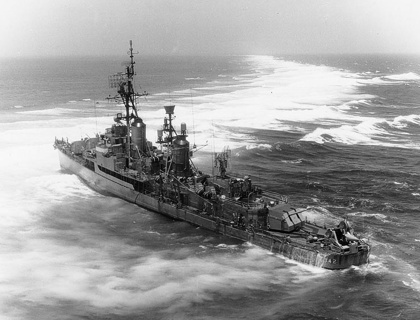
After extensive training on both coasts, Frank Knox arrived in San Pedro Bay, P.I., on 16 June 1945 to join the fast carrier task forces in their raids against the Japanese home islands. With such a force, she entered Sagami Wan on 27 August, and was present in Tokyo Bay during the surrender ceremonies on 2 September. She served on occupation duty in the Far East until sailing for San Diego, her home port, on 4 January 1946.
In 1947 and 1948, Frank Knox completed tours of duty in the Far East, and upon the outbreak of the Korean War, sailed on 6 July 1950 to join the Seventh Fleet’s fast carrier task force in air operations against North Korea. During her tour of duty, she also took part in the Inchon invasion, conducted shore bombardments, patrolled the Taiwan Straits and, on 30 January 1951, joined in a mock invasion of the North Korean coast. This deception proved so effective that Communist troops were withdrawn from central Korea for a time. A final 40-day period was spent in bombardment of the east coast rail centers, Chongjin and Songjin, cutting supply and communications routes.
Returning to San Diego 11 April 1951, Frank Knox operated along the west coast and in the Hawaiians until 19 April 1952, when she sailed for Korean service again. Her duty, similar to that of her first wartime tour, included several weeks in Wonsan Harbor to give fire support to minesweepers. The destroyer returned to West Coast duty on 18 November 1952. During her 1953 Far Eastern cruise, which coincided with the Korean armistice, Frank Knox conducted patrols, and covered the transportation of former Chinese prisoners of war who had elected to go to Taiwan rather than return from Korea to mainland Communist China.

Source: Naval History & Heritage Command.
Frank Knox stranded on Pratas Reef, South China Sea, July 1965.
Her next tour of duty in the western Pacific, in 1955, found Frank Knox taking part in the evacuation of the Tachen Islands. Her annual deployments to the Far East through 1962 included intensive training operations, often with ships of foreign navies, and good will visits to many ports under the President’s “People-to-People” program. Several times she visited ports in Australia and New Zealand.
In 1960–1961 Frank Knox was modernized under the FRAM II program, which gave her updated radar and other new equipment. She was based in the Far East from late 1961 until mid-1964, then returned home via Australia and the South Pacific.
Deployed again in June 1965, she served briefly off Vietnam conducting naval gunfire support and coastal patrol operations. While underway in the South China Sea on 18 July, she ran aground on Pratas Reef, and was only freed after a very difficult salvage effort. After extensive repairs at Yokosuka, Japan, Frank Knox rejoined the active forces in November 1966 and resumed her pattern of nearly annual Seventh Fleet cruises, frequently taking part in Vietnam combat missions. Redesignated DD 742 at the on 1 January 1969, she completed her final deployment in November 1970 and was decommissioned at the end of January 1971.
On 3 February 1971, Frank Knox was transferred to the Greek Navy. Until 31 August 1992, she served in the Hellenic Navy as Themistoklis (D-210) before being retired. She was sunk on 12 September 2001 as a torpedo target by the Greek Submarine Nereus (S-111).